US Gas Use Up Almost 1% in 2016, Coal Plunges 9%
US primary energy consumption increased by just 0.08% to 97.42 quadrillion Btu last year, from 97.34 quadrillion Btu in 2015.
Natural gas consumption in the US increased by 0.9% to 27.5 trillion ft3 in 2016 (so to 75.34bn ft3/d) led by higher demand from power generators and industry, said the US government's Energy Information Adminstration April 5, although its use in the residential and commercial sectors fell slightly because of lower heating demand.
US coal consumption declined by 9% in 2016, almost offsetting increases in oil, gas, renewables and nuclear energy consumption, according to the latest US Energy Information Administration data, with coal use by power generators down by 8% and down by 11% by industry. US nuclear energy consumption increased 1% in 2016; oil consumption too increased by 1% to 19.6mn barrels per day.
Renewable energy had the largest increase in energy consumption in 2016 to just over 10 quadrillion Btu, with wind energy consumption up almost 20% on 2015, making up nearly half the 0.7 quadrillion Btu increase for renewables.

US consumption trends for major fuels (Graphic credit: US Energy Information Adminstration)
Lower-48 US underground natural gas storage design capacity increased by 0.7% in 2016 to 4,688 bn ft3 – the third consecutive year of small capacity increases, the EIA also reported April 4. The biggest increase was in the ‘South Central’ region that includes the Henry Hub gas hub and the gas-rich states of Texas and Louisiana.
EIA also reported March 31 that US energy production fell by 4% to 84.1 quadrillion Btu in 2016, its first annual decline since 2009. Coal production fell by 18%, while gas and oil declined by 2.2% and 5% respectively, impacted by lower prices for both commodities. Dry gas production in 2016 was 26.465 trillion ft3 (up 2.2%), equivalent to 72.5bn ft3 per day. The US will become a net exporter of natural gas on an annual basis by 2018, the EIA recently forecast, as domestic production continues to grow and new gas export capacity especially to Mexico starts up.
The US in 2015 was the world's second largest energy consuming nation, after China, according to last June's BP Statistical Review of World Energy.
Mark Smedley





